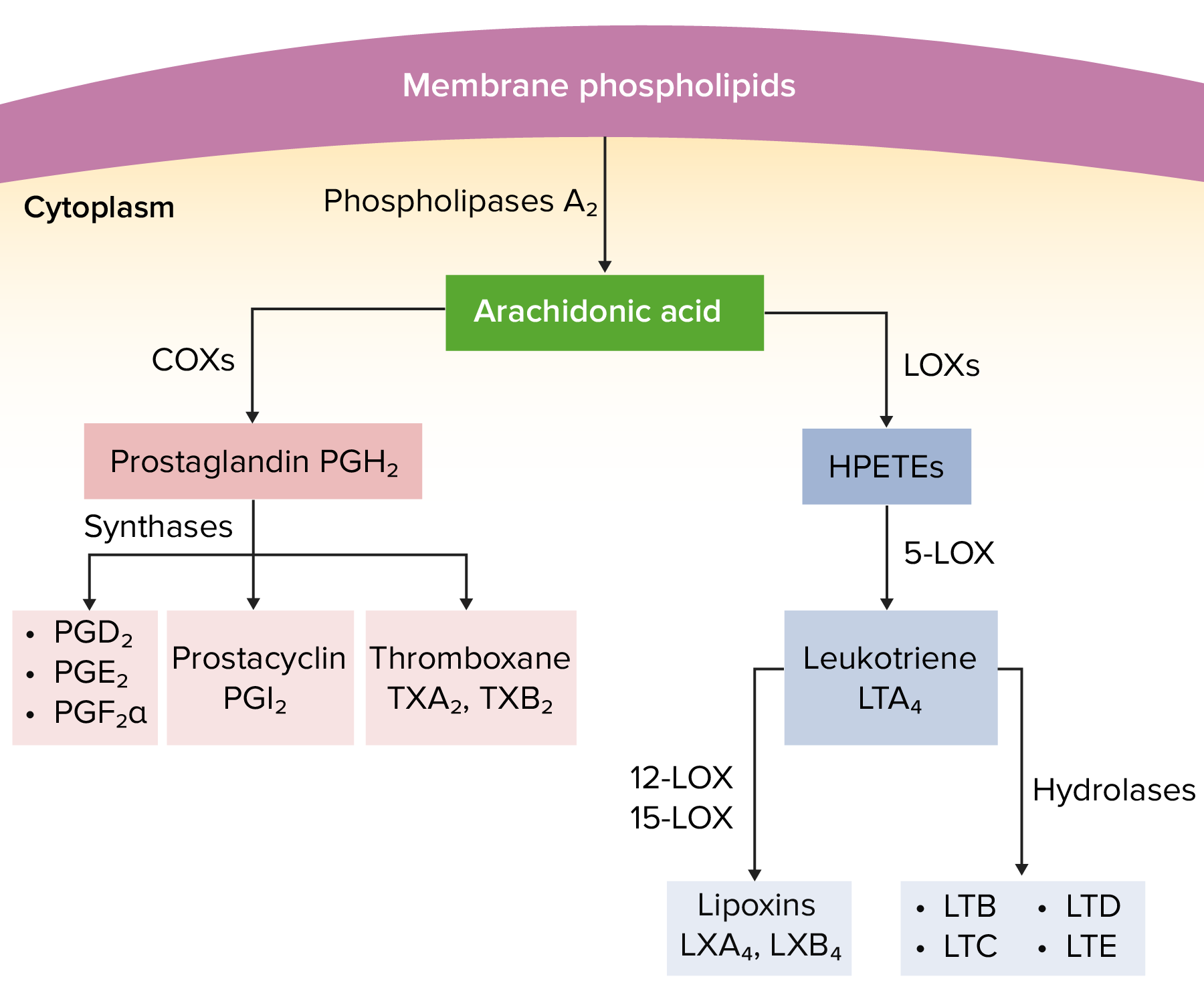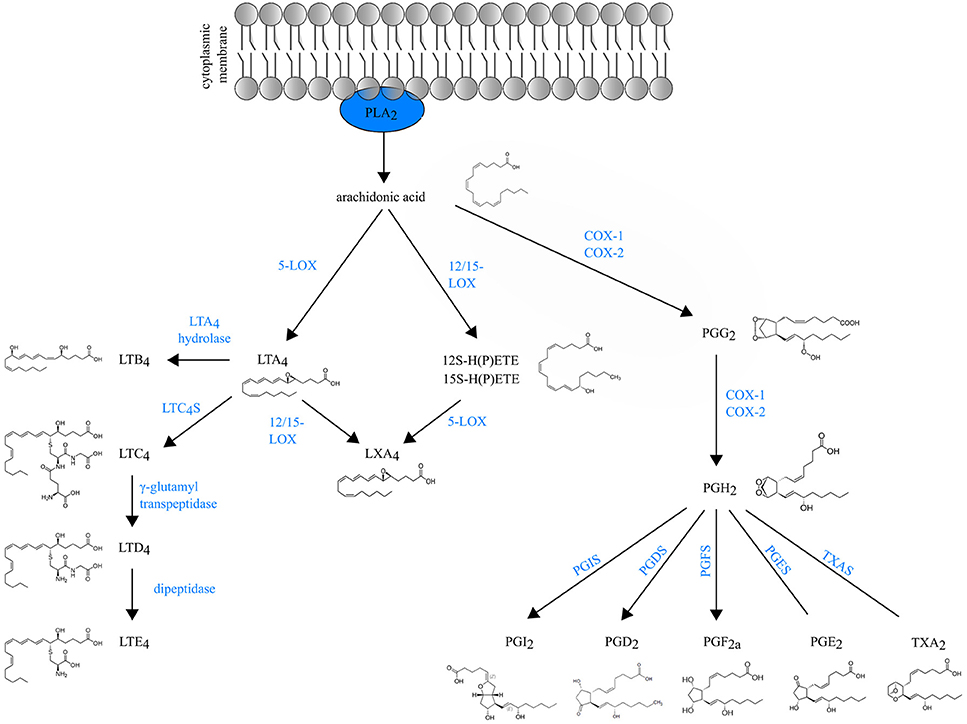Playlist
Show Playlist
Hide Playlist
Pharmacology of Inflammation
-
Slides Pharmacology of Inflammation.pdf
-
Reference List Pharmacology.pdf
-
Download Lecture Overview
00:01 Welcome to pharmacology by Lecturio. I'm Dr. Pravin J Shukle, we're going to be going over inflammation and the drugs that we use to mitigate it. 00:13 Okay guys, we're going to do a really complicated graphic. It's gonna take us about 5 minutes, but what I'm going to do in the next 5 minutes is summarise an entire 3 month course in inflammation. So let's start with a stimulus. 00:27 This stimulus affects the cell membrane. It disturbs it somehow. Well your cell membrane, don't forget, is made up of a whole bunch of phospholipids. Now these phospholipids conveniently are precursors to many of the signals that we have for inflammation. 00:44 So the phospholipids have arachidonic acid enmeshed within them. And this arachidonic acid is broken down by phospholipase A2. 00:56 Now, it makes sense that the first step of inflammation is inhibition. The first step that we can use to inhibit inflammation is inhibiting that phospholipase A2. We do that with phospholipase inhibitors and with corticosteroids. 01:12 Let's move on to the arachidonic acid. Now, arachidonic acid, is also going to be brought about in increasing levels with a high fat acid diet. So if we theoretically substitute a high fat diet with a low fatty acid substitution diet, we may be able to reduce the levels of arachidonic acid in our body. That's the theory behind, let's call it a naturopathic movement to have a fatty acid substitution diet to reduce inflammation. Unfortunately it doesn't work as well in the real world as we would have thought. Now from arachidonic acid we develop leukotrienes. Okay, what's a leukotriene? A leukotriene is a complex molecule that's broken down from arachidonic acid by lipoxygenases. 02:03 Now, to stop that process we can use lipoxygenase inhibitors. Leukotrienes have many subtypes, and they come with letter alphanumeric designations that are sometimes quite confusing and really, you don't have to memorize the different types of leukotrienes for your exams. I think the most important idea is to recognize, that arachidonic acid forms leukotrienes. 02:29 Now these leukotrienes alter the way the blood vessels work. They alter what's called vascular permeability. 02:37 They also work in lung bronchis, so they alter bronchial constriction. And they also cause an increased secretion of mucous. So you can see, just in your own mind how this can be very useful in asthma. Now if you go back to your asthma lectures we talk about leukotriene antagonists, as being almost as effective as steroids. 02:59 Now, bronchospasm, congestion and mucous plugging occur with excess leukotrienes. So a leukotriene antagonist will help prevent that. 03:09 Other things that are brought about from arachidonic acid include things like prostacyclin and thromboxane, and of course the prostaglandins. Now the prostaglandins and the leukotrienes are kind of two sides of the seesaw, that go back and forth and they help mitigate inflammation in the cells that we talked about with the leukotrienes. 03:32 Cyclooxygenase is the enzyme that takes arachidonic acid and turns it into any one of those other molecules, but not leukotrienes. So this is an important point. Cyclooxgenase turns arachidonic acid into prostacyclin, thromboxane or a prostaglandin. Lipoxygenase, turns arachidonic acid into one of the leukotrienes. 04:00 Now it seems that we need a stop point for cyclooxygenase, and it is, you guessed it, aspirin. 04:06 So aspirin is a cyclooxygenase inhibitor. That's how it works to reduce inflammation, because it prevents the formation of those three agents. 04:18 Now, thromboxane is particularly important with leukocyte modulation. Therefore, inflammation of a certain type is mediated through thromboxane. 04:30 Now let's talk about one of the types of leukotrienes. It's leukotriene B4. 04:37 Leukotriene B4 is responsible for phagocyte attraction and activation. Phagocytes if you remember are those white blood cells that eat up other organisms. 04:49 Now leukotriene mediation can be blocked right at the receptor site by receptor antagonists. So you could have leukotriene B4 antagonists, you could have leukotriene C4 or C2 or D4 or E4. It doesn't matter what type of leukotriene, for almost every leukotriene we've developed a receptor antagonist for it. The one that I think you're probably the most familiar with are the ones that are working in the lungs. 05:15 Now remember that leukotriene B4 is involved in a different kind of inflammatory response as the leukotrienes that are in the other category. So I've separated them out and we're gonna talk about them separately later. 05:30 Colchicine blocks that leukotriene B4 inflammation. Remember that word, colchicine. 05:38 Okay so, I'm really proud of you. You manage to make it through a 3 month pharmacology of inflammation lecture, in 5 minutes. Let's move on to a specific group of anti-inflammatory agents called non steroidal anti-inflammatory agents. 05:53 So these are a class of drugs that work through the cyclooxygenase pathway. The non steroidal anti-inflammatory agents can include aspirin. They include other non-selective, non-steroidal anti-inflammatory agents like ibuprofen, which is commonly sold as Advil. And we have specific cyclooxygenase type 2 inhibitors like celecoxib. 06:19 We have other types of anti-inflammatory drugs, they are called the DMARDs. Disease modifying anti-rheumatic drugs. 06:29 So they can be cytotoxic, they can work on T-lymphocyte activity, or B-lymphocyte activity, or macrophage activity, or biologics. Now we also have drugs that are used in gout. Drugs that are used in acute gout, which are the NSAIDs that are on the other side, the left side of your screen, we have glucocorticoids, which we covered in previous lectures, and we have colchicine. 06:51 And we have chronic treatment of gout. That can involve uricosurics, and xanthine oxidase inhibitors. We'll talk about those more later. 07:01 Acetaminophen is sort of this other drug that sort of straddles everything. Is acetaminophen an anti-inflammatory agent or not? In my personal opinion, I would categorize it as a anti-pyretic agent and analgesic medication, I don't classify it in my practice as an anti-inflammatory agent, but admittedly it does have some anti-inflammatory reactivity.
About the Lecture
The lecture Pharmacology of Inflammation by Pravin Shukle, MD is from the course Inflammation Pharmacology.
Included Quiz Questions
What is CORRECT regarding arachidonic acid?
- Arachidonic acid is made from phospholipids and this reaction is catalyzed by the enzyme phospholipase A2.
- Arachidonic acid is catabolized by the enzyme phospholipase A2.
- Arachidonic acid is converted into phospholipids by the enzyme phospholipase A2.
- Arachidonic acid and phospholipase A2 do the same thing.
- Phospholipase A2 is a steric inhibitor at arachidonic acid receptors.
What is INCORRECT regarding leukotrienes?
- Leukotrienes are made of sphingolipids.
- Leukotrienes alter vascular permeability.
- Leukotrienes induce bronchoconstriction.
- Leukotrienes increase secretions in the lungs.
- Leukotrienes are derived from phospholipids.
What is NOT an inhibitor in the inflammation pathway?
- Phospholipase A2
- Corticosteroids
- NSAIDs
- Aspirin (ASA)
- Lipoxygenase inhibitor
What is NOT a product of arachidonic acid?
- Cortisol
- Prostacyclin
- Thromboxane
- Prostaglandin
- Leukotrienes
What best describes the difference between NSAIDs and acetaminophen?
- NSAIDs are anti-inflammatory while acetaminophen is more of an antipyretic and analgesic.
- NSAIDs and acetaminophen work on the same molecular target.
- Acetaminophen is anti-inflammatory while NSAIDs are not.
- Acetaminophen is rarely used in modern medicine.
- NSAIDs are rarely used in modern medicine.
Customer reviews
5,0 of 5 stars
| 5 Stars |
|
2 |
| 4 Stars |
|
0 |
| 3 Stars |
|
0 |
| 2 Stars |
|
0 |
| 1 Star |
|
0 |
Am been top of class always when ít comes pharmacology
best teacher eveeer! He makes it so easy! I want him as a teacher in my University! in peru!





